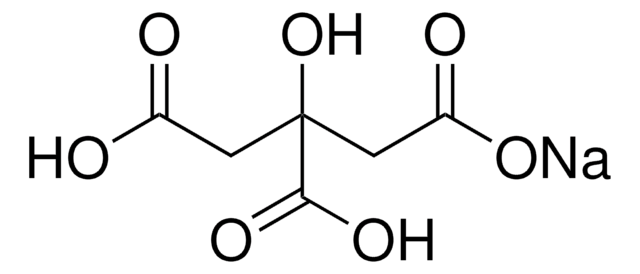71406
Sodio citrato tribasico
purum p.a., ≥99.0% (NT)
Sinonimo/i:
Acido citrico, Trisodio citrato
About This Item
Prodotti consigliati
Grado
purum p.a.
Livello qualitativo
Saggio
≥99.0% (NT)
Forma fisica
crystals
pH
7.0-9.0 (25 °C, 50 mg/mL in H2O)
Punto di fusione
>300 °C (lit.)
Solubilità
water: very soluble 24.9 g/L at 20 °C
Anioni in tracce
chloride (Cl-): ≤50 mg/kg
sulfate (SO42-): ≤50 mg/kg
Cationi in tracce
Ca: ≤50 mg/kg
Cd: ≤50 mg/kg
Co: ≤50 mg/kg
Cu: ≤50 mg/kg
Fe: ≤50 mg/kg
K: ≤100 mg/kg
Ni: ≤50 mg/kg
Pb: ≤50 mg/kg
Zn: ≤50 mg/kg
Stringa SMILE
O.O.[Na+].[Na+].[Na+].OC(CC([O-])=O)(CC([O-])=O)C([O-])=O
InChI
1S/C6H8O7.3Na.2H2O/c7-3(8)1-6(13,5(11)12)2-4(9)10;;;;;/h13H,1-2H2,(H,7,8)(H,9,10)(H,11,12);;;;2*1H2/q;3*+1;;/p-3
NLJMYIDDQXHKNR-UHFFFAOYSA-K
Cerchi prodotti simili? Visita Guida al confronto tra prodotti
Codice della classe di stoccaggio
11 - Combustible Solids
Classe di pericolosità dell'acqua (WGK)
WGK 1
Punto d’infiammabilità (°F)
Not applicable
Punto d’infiammabilità (°C)
Not applicable
Dispositivi di protezione individuale
Eyeshields, Gloves, type N95 (US)
Scegli una delle versioni più recenti:
Possiedi già questo prodotto?
I documenti relativi ai prodotti acquistati recentemente sono disponibili nell’Archivio dei documenti.
I clienti hanno visto anche
Il team dei nostri ricercatori vanta grande esperienza in tutte le aree della ricerca quali Life Science, scienza dei materiali, sintesi chimica, cromatografia, discipline analitiche, ecc..
Contatta l'Assistenza Tecnica.






